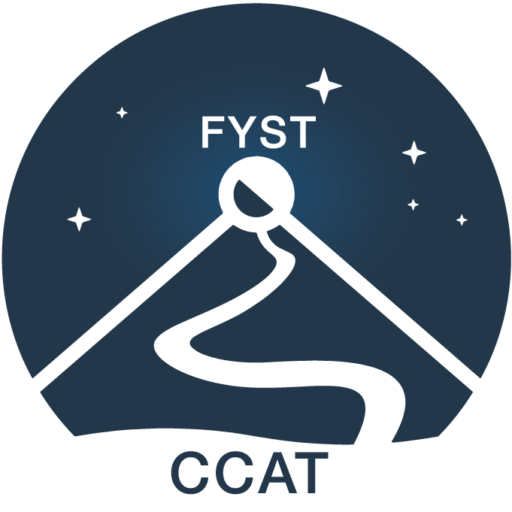The Fred Young Submillimeter Telescope is specifically designed to measure the kinematic Sunyaev-Zel’dovich effect of galaxy clusters, to trace the appearance of the first population of star-forming galaxies through intensity mapping of their [CII] emission in the epoch of reionization, and to probe multiple spectral line tracers of the ISM over a range of environments in the Milky Way, Magellanic Clouds and other nearby galaxies. It will also be a next-generation Cosmic Microwave Background observatory.
With the Fred Young Submillimeter Telescope (FYST), our science partnership will undertake major scientific programs to measure the motions and temperatures of galaxy clusters via the Sunyaev-Zel’dovich effect, to trace the appearance of the first population of star-forming galaxies through intensity mapping of their [CII] emission in the epoch of reionization, and to probe, by mapping a variety of molecular spectral line tracers, the dynamics of the interstellar medium in a wide range of environments in the Milky Way, the Magellanic Clouds and other nearby galaxies. The FYST will also be a next-generation Cosmic Microwave Background (CMB) observatory, offering the capability to map the sky some 10 times faster than current CMB facilities. While other CMB efforts focus on wavelengths longer than one millimeter, the availability of simultaneous submillimeter imaging offered by the FYST will allow precise separation of emission by foreground dust from the CMB signal.
Science Projects
- Tracing the epoch of reionization with CII intensity mapping
Lead: Dominik Riechers (UKöln)
Deputy Lead: Gordon Stacey (Cornell)
- Understanding galaxies and galaxy cluster formation via millimeter and submillimeter observations
Lead: Nick Battaglia (Cornell)
Deputy Lead: Kaustuv Basu (UBonn)
- Enhancing constraints on new particle species and cosmology with Rayleigh Scattering
Lead: Daan Meerburg (UToronto)
Deputy Lead: Joel Meyers (SMU)
- Measuring CMB foreground to aid the search for primordial gravitational waves
Lead: Mike Niemack (Cornell)
Deputy Lead: Steve Choi (UC Riverside)
- Tracing galaxy evolution from the first billion years to Cosmic Noon with the cosmic infrared background
Co- Lead: Scott Chapman (UBritish Columbia)
Co-Lead: Manuel Aravena (UDiego Portales)
Deputy Lead: Thomas Nikola (Cornell)
- The star formation-ISM cycle in local galaxies with high spectral resolution submillimeter observations
Lead: Robert Simon (U.Köln)
Co-Deputy Lead: Frank Bigiel (UBonn)
Co-Deputy Lead: Amelia Stutz (UConcepción)
- A new submillimeter window into time domain astrophysics
Co-Lead: Doug Johnstone (NRC-CNRC)
Co-Lead: Anna Ho (Cornell)
Deputy Lead: Greg Sivakoff (UAlberta)
- Magnetic fields and broadband galactic polarization science
Lead: Laura Fissell (Queens U)
Clark: Susan Clark (Stanford)
Kinetic Sunyaev-Zel’dovich Effect
- S-Z Effect: Distortions in the Cosmic Microwave Background (CMB) spectrum are seen when CMB photons travel through the hot intra-cluster medium of clusters of galaxies along the line of sight.
- It is important to characterize and remove CMB, tSZ, bright submm galaxies and radio sources which CCAT does in the short submm bands − CCT can observe over wider range from submm to mm at once.
- Will yield improved constraints on models of dark energy and modified gravity based on measuring 1000 clusters with 100 km/s accuracy.
- Will also enable a measurement of the sum of neutrino masses, another important cosmological prediction.
Intensity Mapping of [CII] from the EOR
- Detect aggregate clustering signal of faint galaxies in the epoch of reionization (EOR) via redshifted [CII] 158 μm line.
- Directly traces sources of reionization (star forming galaxies) over the time interval of “Cosmic Dawn”.
- Recent ALMA detection of [CII] in “normal” galaxies at z = 5-6 (e.g. Riechers et al., 2014, ApJ 796, 84).
- Enhanced [CII] to dust continuum compared to lower redshifts à strong signal.
Galactic Ecology of the Dynamic ISM
- Spectral mapping of fine structure and mid-/high-excitation CO lines as diagnostics of physical conditions and motions of interstellar clouds. For background information, see the decadal review 2020 white paper.
- Lines trace coolants in range environments where stars and planets form.
- Maps at (15”× λ/350μm) resolution over degree scales of Milky Way including Galactic Center and Magellanic Clouds (low metallicity).
- High site provides unique access to shortest wavelength.
- Builds on SOFIA (2.5m) with better resolution, much more observing time.
Stage IV CMB Platform
- Could map the CMB at 10 times the speed of current telescopes.
- Submm coverage will provide galactic foreground removal for other CMB efforts.
- Many synergies with planned Simons Observatory.
